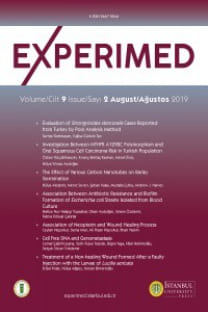Multipl Sklerozda Sistemik Otoantikor Pozitifliğinin Oligoklonal Band Varlığı ve Özürlülük ile İlişkisi
xx
Association of Systemic Autoantibody Positivity with the Presence of Oligoclonal Bands and Disability in Multiple Sclerosis
___
- Andersson M, Alvarez-Cermeno J, Bernardi G, Cogato I, Fredman P, Frederiksen J, Fredrikson S, Gallo P, Grimaldi LM, Gr0nning M. Cerebrospinal fluid in the diagnosis of multiple sclerosis: a consensus report. J Neurol Neurosurg Psychiatry 1994; 57: 897-902.
- Annunziata P, Lore' F, Venmrini E, Morana P, Guarino E, Borghi S, Guazzi GC. Early synthesis and correlation of serum anti-thyroid antibodies with clinical parameters in multiple sclerosis. J Neurol Sci 1999; 168: 32-6.
- Archelos JJ, Storch MK, Hartung HP. The role of B cells and autoantibodies in multiple sclerosis. Ann Neurol 2000; 47: 694-706.
- Collard RC, Koehler RP, Mattson DH. Frequency and significance of antinuclear antibodies in multiple sclerosis. Neurology 1997; 49: 857-861.
- Dittel BN. CD4 T cells: Balancing the coming and going of autoimmune-mediated inflammation in the CNS. Brain Behav Immun 2008; 22: 421-430.
- Heinzlef O, Weill B, Johanet C, Sazdovitch V, Caillat-Zucman S, Tournier-Lasserve E, Roullet E. Anticardiolipin antibodies in patients with multiple sclerosis do not represent a subgroup of patients according to clinical, familial, and biological characteristics. J Neurol Neurosurg Psychiatry 2002; 72:647-9.
- Idirnan E, Ozakbas S, Dogan Y, Kosehasanogullari G. The significance of oligoclonal bands in multiple sclerosis: relevance of demographic and clinical features, and immunogenetic backgrounds. J Neuroimmunol 2009; 212: 121-4.
- Jacob S, Zarei M, Kenton A, Allroggen H. Gluten sensitivity and neuromyelitis optica: two case reports. J Neurol Neurosurg Psychiatry 2005; 76: 1028-30.
- Karussis D, Leker R R, Ashkenazi A, Abramsky O. A subgroup of multiple sclerosis patients with anticardiolipin antibodies and unusual clinical manifestations: do they represent a new nosological entity? Ann Neurol 1998; 44: 629-34.
- Koch M, Heersema D, Mostert J, Teelken A, De Keyser J. Cerebrospinal fluid oligoclonal bands and progression of disability in multiple sclerosis. Eur J Neurol 2007; 14: 797-800.
- Korn T. Pathophysiology of multiple sclerosis. J Neurol 2008; 255: 2-6.
- McDonald ND, Pender MP. Autoimmune hypothyroidism associated with interferon beta-lb treatment in two patients with multiple sclerosis. Aust NZ J Med 2000; 30:278-9.
- Monzani F, Caraccio N, Dardano A, Ferrannini E. Thyroid autoimmunity and dysfunction associated with type I interferon therapy. Clin Exp Med 2004; 3: 199¬210.
- Munteis E, Cano JF, Flores JA, Martinez-Rodriguez JE, Miret M, Roquer J. Prevalence of autoimmune thyroid disorders in a Spanish multiple sclerosis cohort. Eur J Neurol 2007; 14: 1048-52.
- Niederwieser G, Buchinger W, Bonelli RM, Berghold A, Reisecker F, Koltringer P, Archelos JJ. Prevalence of autoimmune thyroiditis and non-immune thyroid disease in multiple sclerosis. J Neurol 2003; 250: 672¬5.
- Reindl M, Khalil M, Berger T. Antibodies as biological markers for pathophysiological processes in MS. J Neuroimmunol 2006; 180: 50-62.
- Rinker Jr 2nd, Trinkaus K, Naismith RT, Cross AH. Higher IgG index found in African Americans versus Caucasians with multiple sclerosis. Neurology 2007; 69: 68-72.
- Salvatore S, Finazzi S, Ghezzi A, Tosi A, Barassi A, Luini C, Bettini B, Zibetti A, Nespoli L, Melzi d'Eril GV. Multiple sclerosis and celiac disease: is there an increased risk? Mult Scler 2004; 10: 711-712.
- Siritho S, Freedman MS. The prognostic significance of cerebrospinal fluid in multiple sclerosis. J Neurol Sci 2009; 279: 21-5.
- Vilisaar J, Wilson M, Niepel G, Blumhardt LD, Constantinescu CS. A comparative audit of anticardiolipin antibodies in oligoclonal band negative and positive multiple sclerosis. Mult Scler 2005; 11: 378-80.
- Yayın Aralığı: Yılda 3 Sayı
- Başlangıç: 2011
- Yayıncı: İstanbul Üniversitesi
TİP 1 DİYABETTE NKT HÜCRELERİNİN ROLÜ
G. ERŞAHİN, S. BİLGİÇ, E. AKTAŞ, F. SALMAN, G. DENİZ
Hayatının Anlamına "Bilim" Diyen bir Bilim İnsanının Anısına
“XV. UYGULAMALI FLOW SİTOMETRİ EĞİTİMİ”NİN DEĞERLENDİRİLMESİ
Suzan Adın ÇINAR, Suzan ÇINAR, Gaye ERTEN, Esin AKTAŞ ÇETİN, Sema BİLGİÇ GAZİOĞLU, Umut KÜÇÜKSEZER, Ali GÜROL, Gülderen YANIKKAYA DEMİREL, Günnur DENİZ
Hayatının Anlamına "Bilim" Diyen bir Bilim İnsanının Anısına
DETAE'DE OCAK 2010-TEMMUZ 2011 TARiHLERi ARASINDA TAMAMLANMIS DOKTORA VE YUKSEK LiSANS TEZLERi
Duran ÜSTEK, Neslihan ABACI, Sema SIRMA, Aris ÇAKİRİS
DİYABET HASTALIĞINDA OSTEOPROTEGERİN (OPG) PROTEİNİ T950C GEN POLİMORFİZMİNİN İNCELENMESİ
Burak ESEN, Selçuk DAŞDEMİR, Zeynep ÇİNÇİN, Abdullah ÖZDEMİRCAN, Bedia ÇAKMAKOĞLU
İstanbul Üniversitesi Deneysel Tıp Araştırma Enstitüsü Tarihçesi
